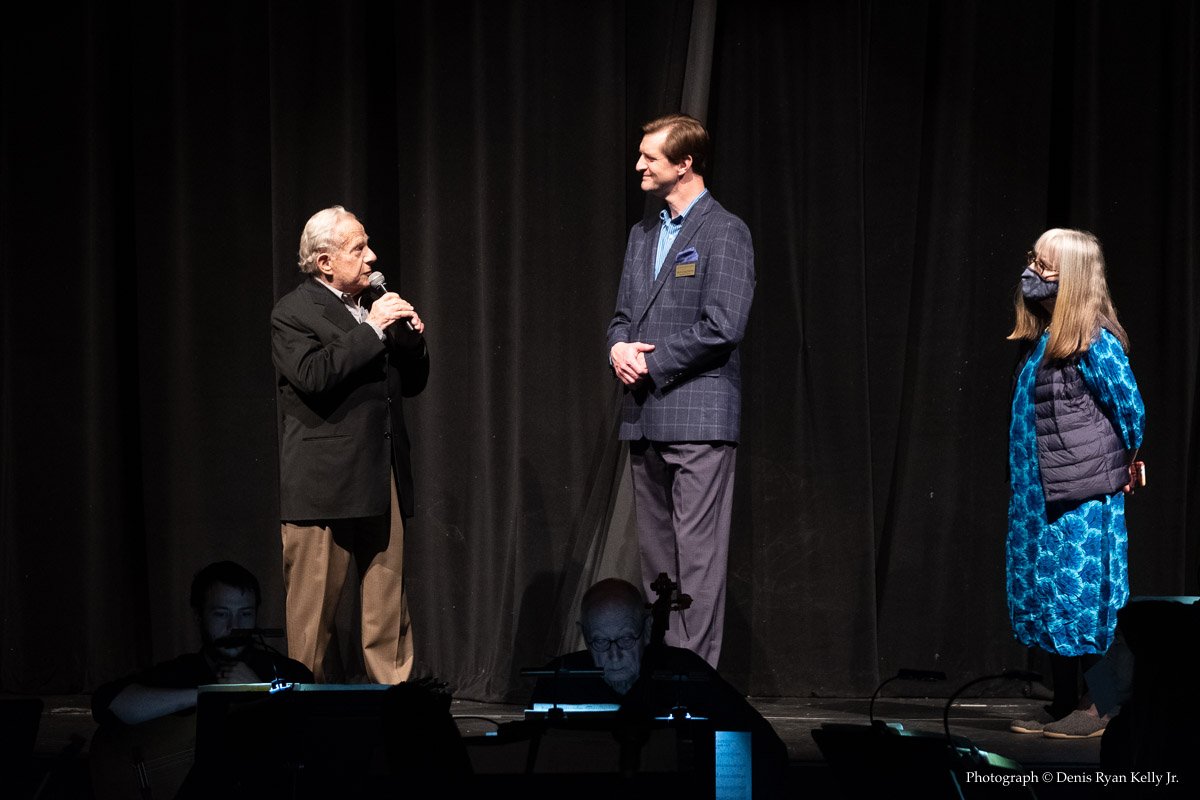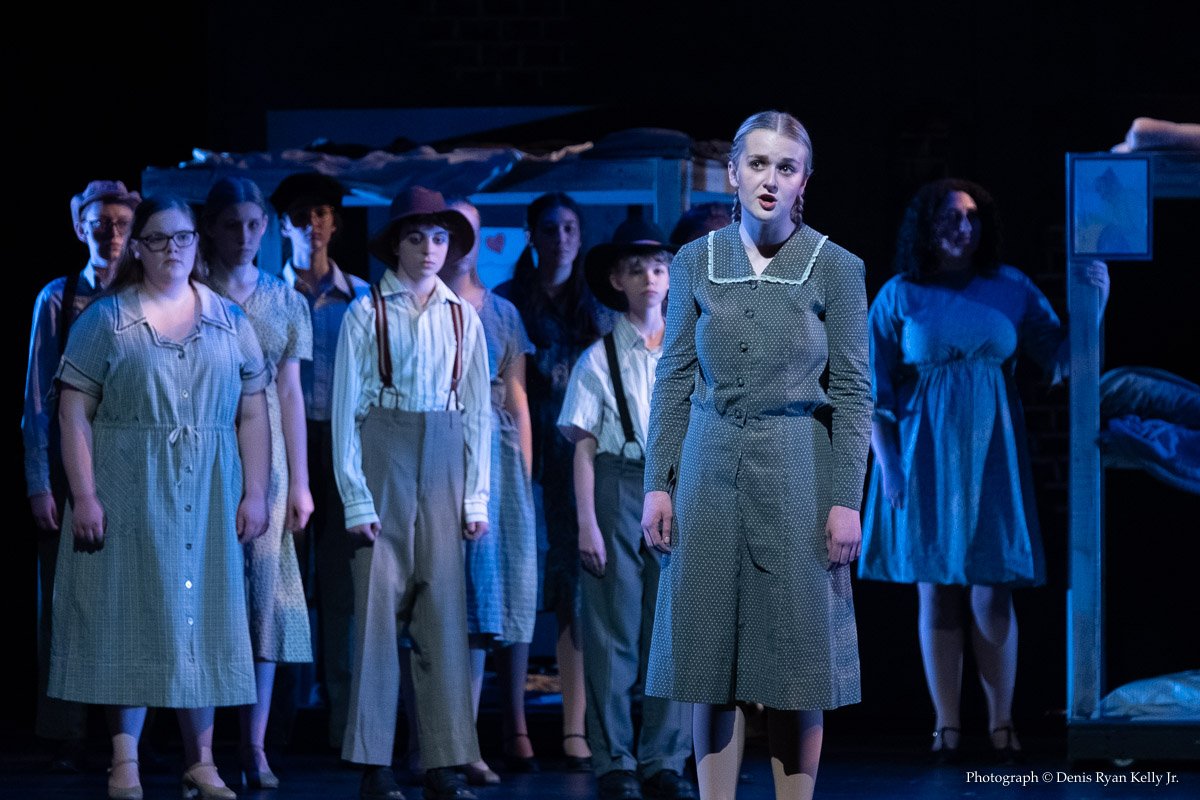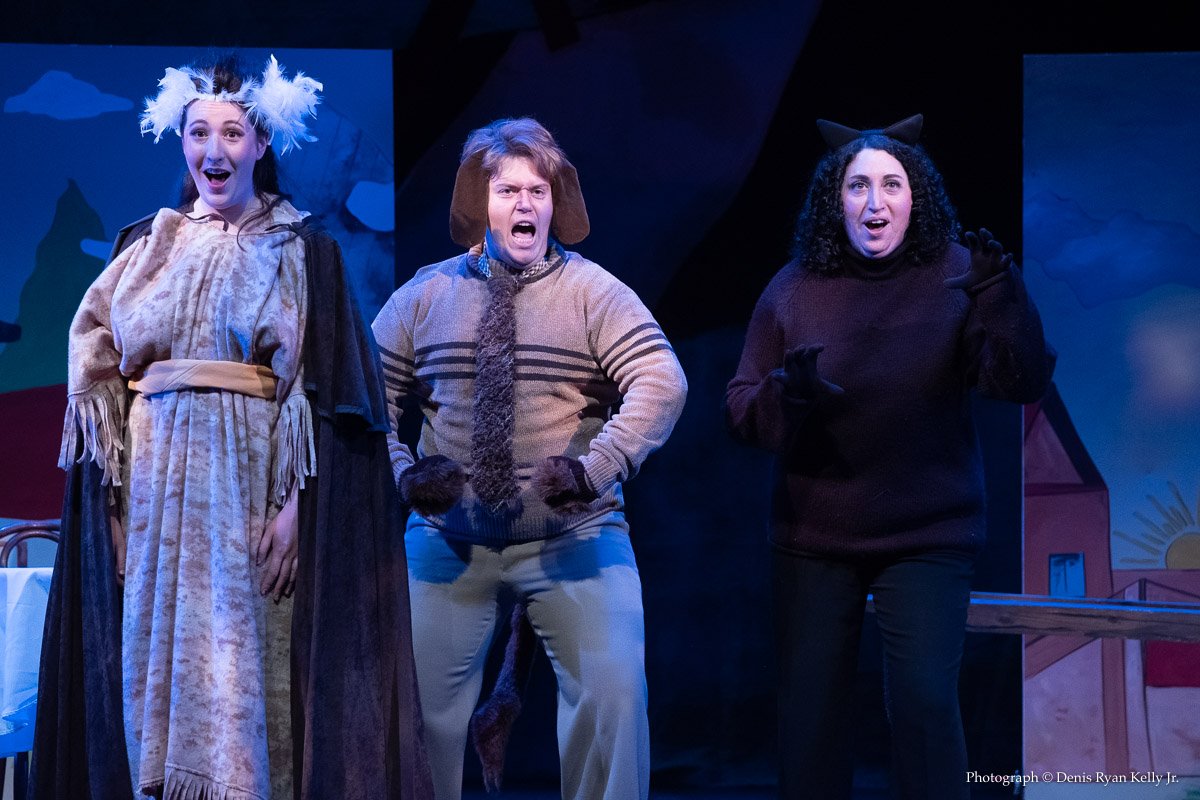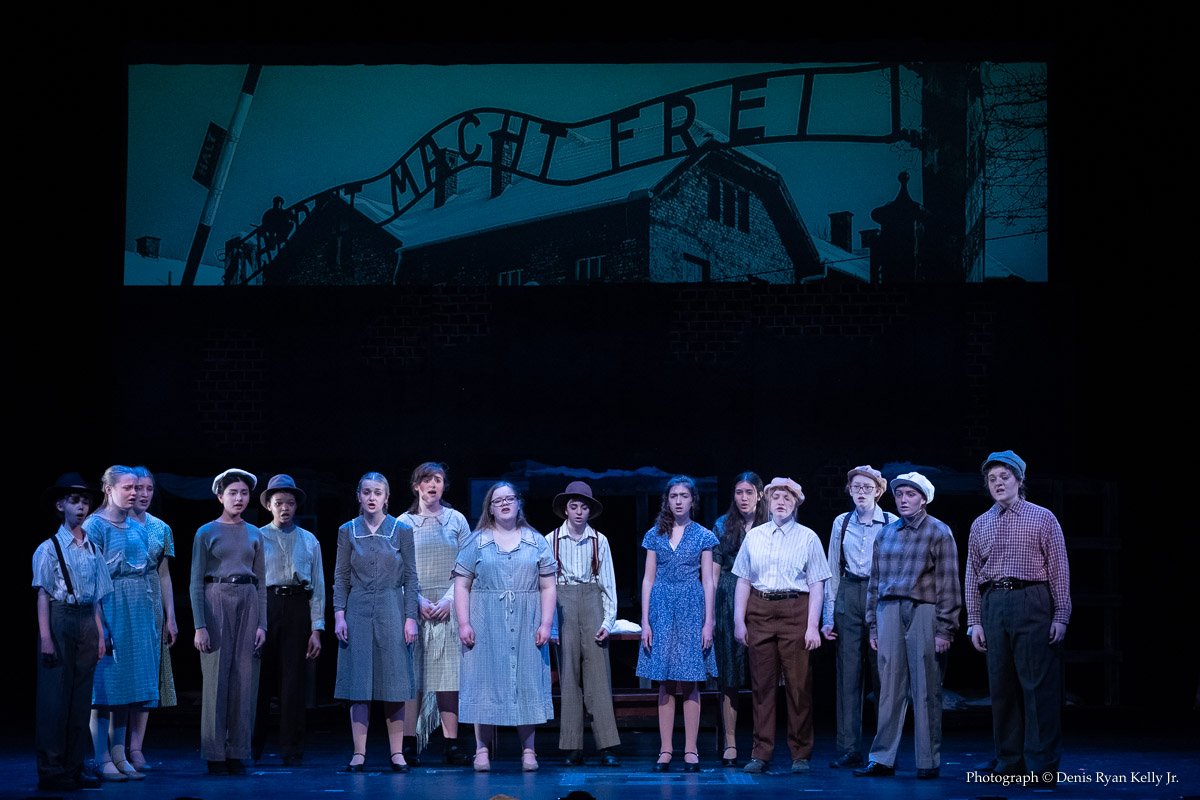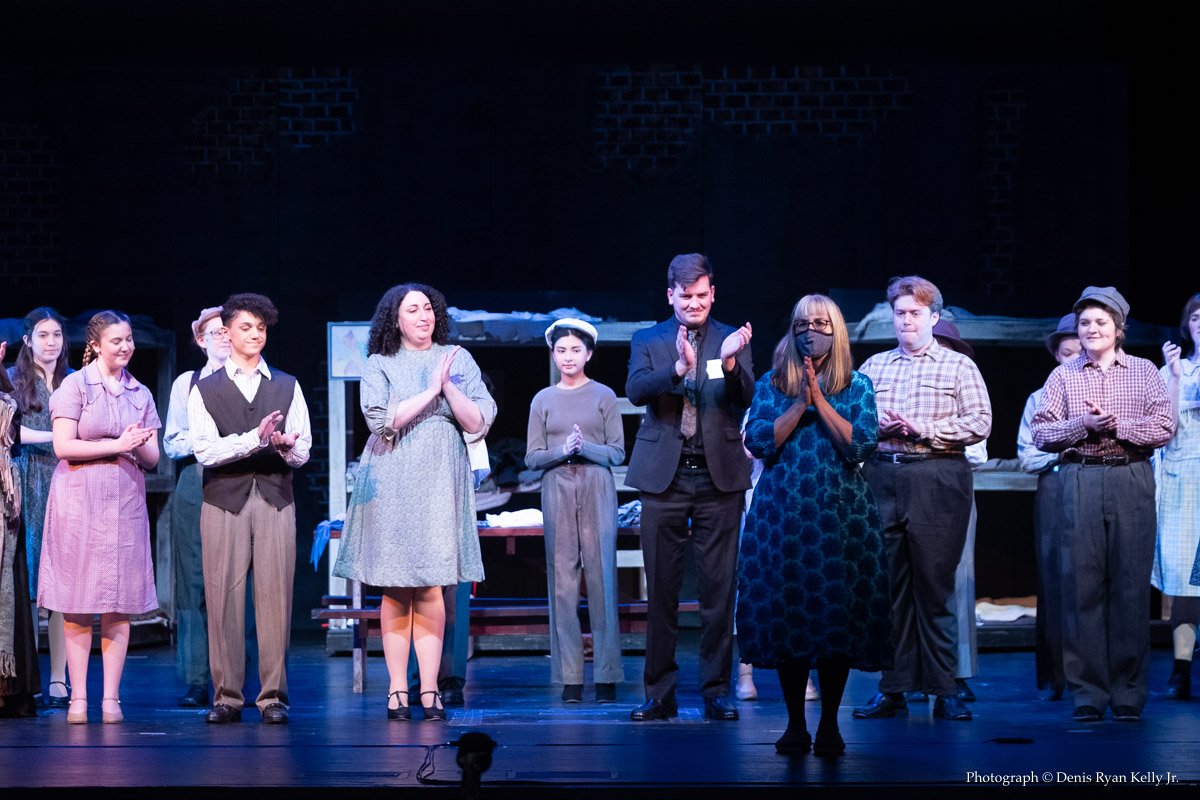Brundibar by Hans Krása
Vedem by Lori Laitman (2022)
Stage Director / Designer, Indianapolis Opera
Members of the Indianapolis Children’s Choir and Brundibar soloists sing the final victory march.
Producer: Indianapolis Opera
Conductor: Alfred Savia
Director of Production: Eric Matters
Costumes: Costume World
Muralist: Lyndsay Moy
Lighting Design: Quinten James
Projection Design: Zach Rosing
Sound Design: Zach Rosing
Props Manager: Marta Hamilton
Production Stage Manager: Philip Christiansen
Assistant Stage Manager: Marta Hamilton
Performance Photography: Denis Ryan Kelly Jr.
Performance Videography: WFYI (IN PBS Affiliate)
Performance Credits
Vedem mezzo soloist/Brundibar Cat: Cornelia Lotito
Vedem tenor soloist/Brundibar Dog: Joseph McBrayer
Brundibar: Bernardo Medeiros
Bird: Amanda Levy
Annette: Jordan Pecar
Little Joe: Cashmere Moore
Policeman: Ella Williams
Baker: Madison Berry
Ice Cream Man: Ashley Aldridge
Milkmaid: Madison Fleener
Chorus: Indianapolis Children’s Choir
Navigation
Historical Perspective
The Theresienstadt Transport Camp
Both Brundibar and Vedem have their roots in the Nazi-run transport camp of Theresienstadt or Terezín. The camp was located north of the capital city of Prague in occupied Czechoslovakia and was situated in close proximity to the borders of Germany and Poland. While the camp primarily housed Czech Jews, there were also prisoners from Germany, Austria, and Denmark. Prisoners were not subject to extermination while in the camp, but their existence was a thoroughly dehumanizing one. Prisoners were sorted into cramped living arrangements based on their age and gender, they were given inadequate food, and adults were put into forced labor assignments. Children fared slightly better, often receiving slightly more substantial food rations and some better housing accommodations, but conditions were universally hard within the walls of an old military garrison.
There were several important distinctions between Terezín and other concentration camps at the time. The first was an incredible depth of artistic activity. Through various prisoner testimonies and written accounts, there is evidence that shows that Terezín enjoyed performances of plays, cabarets, orchestras, jazz ensembles, opera, choral music, and much more. For opera alone, there were many titles performed that audiences regularly see today (Carmen, Die Zauberflöte, Le nozze di Figaro, etc.) There was a density of artistic individuals (a mixture of amateurs and professionals) that committed to performing great works of theater and music despite their confined existence.
Initially prisoners were forbidden from performing music or plays, but gradually the camp officials relaxed those restrictions. It was Terezín’s second infamous legacy that led to the performance policy change: Terezín was viewed as a key asset by Nazis for disinformation on a global scale. If they could prove to the international community that the Jews within the walls of Theresienstadt had fulfilling lives where they were separated from society, perhaps they could fool everyone into thinking that every concentration camp was a holding camp rather than the extermination camps found mostly in occupied-Poland.
Joseph McBrayer singing “Five” from Lori Laitman’s Vedem.
Brundibar and Vedem Origins
Brundibar was originally written in 1938 by Hans Krása and Adolf Hoffmeister as part of a short opera contest featuring child performers. Their piece won the contest, and plans were made to stage the opera in 1939 using children at an orphanage in Prague. The opera was performed two times at most at a time when Jews were being forced out of their professions. Nearly three years later, most of the artistic team - including the composer, music director, and stage director - and original performers were reunited in Terezín. The music director Rudi Freudenfeld was the person that brought the score of Brundibar with him into the camp. By 1943, plans were made to revive the opera in the camp. Auditions were held in one of the boys’ barracks, and the show would be rehearsed and performed in the attic of a building where women lived. The opera was performed over 50 times, including one performance for the International Red Cross and another performance that was recorded on film.
In the same building where Brundibar was cast, another fascinating project was underway. In Room 1 (referred to by many as a ‘Home'), a group of 40 boys busied their time with the weekly creation of a magazine called Vedem. The title in Czech translates roughly to “In the lead,” which refers to their room number. The paper was published weekly for two years starting in 1942 and featured articles about life in the camp, short stories, poetry, and occasional illustration. Editions of the paper fluctuated between hand-written and typed copy, but regardless of quality, this paper posed a significant risk to the writers. If their writing was found to accurately portray life in the camp, the Nazis had a track record of severely punishing or executing prisoners who created written records. In reality, the paper was left undiscovered during the camp’s existence, and was successfully hidden away by one of the few remaining survivors - Sidney Taussig. By contrast, The magazine received broader international attention with the publication of We Are Children Just the Same, which translated and contextualized certain articles and contributors in Vedem.
Beautification, the Red Cross Visit, and a Propaganda Film
While the Nazis were trying to outwardly protect the image of Terezín in the international scene, scholars and politicians had enough insight to realize the German’s projection was false. After a sustained campaign led by the Danish government and International Red Cross, plans were eventually made to host an inspection of the camp by outside observers. But formal plans also gave the Nazis time to ‘beautify’ the camp, which included many superficial enhancements (street signs, fake stores, new paint, opened courtyard, etc.) and massive deportation efforts to ease overcrowding.
On June 23, 1944, the inspection of Terezín took place. Camp officials led the observers through the camp on a carefully scripted route. Various children and adults were often coached on various things to do or say as part of the visit; many more people were locked in their rooms for the day during the visit. The visitors must not have questioned what they were presented with very thoroughly, because they issued a favorable report that ultimately parroted what they were told by the SS.
At the end of the camp visit, the visitors were treated to two performances. One performance was an adult choir singing a memorized passage from the Requiem by Verdi. The other was the finale from Brundibar. These two pieces were chosen because they represented a sliver of fact and a mound of fiction. The opera and Requiem were performed before by the prisoners, and Terezín was uniquely dense in terms of its artistic output. But it gave the impression that prisoners had time for leisure and led fulfilling lives, which was certainly not the case.
After the visit, a propaganda film was commissioned by the Nazis to further misinform the global community about conditions in the camp. The Nazis put an inmate in charge of the production, and he was forced to reimagine life inside in ways that hardly resembled day-to-day reality. Brundibar once again was an important part of this film. The finale was captured on film in front of a massive auditorium of onlooking children. Though performances in the past had been attended by children for weeks on end, the film version was shot at a different venue that was far nicer than the attic where the opera first started.
The propaganda film was not released during WWII, but the footage was recovered and can still be seen today. Sadly, many of the participants in the film were almost immediately shipped east to extermination camps, apart from a few exceptions. It would not be until after the camps were liberated that the international community would have survivors and written accounts like Vedem that contradicted the Nazis’ deception in clear and specific means.
Other Learning Resources
-
“The Girls of Room 28” by Hannelore Brenner
“We Are Children Just the Same” by Marie Rút Krizková, Kurt Jirí Kotouc, and Zdenek Ornest
“I Am a Star” by Inge Auerbacher
“The Cat with the Yellow Star” by Susan Goldman Rubin and Ela Weissberger
“Terezín: Voices from the Holocaust” by Ruth Thomson
-
“The Boys of Terezín” by John Sharify (documentary)
“Defiant Requiem” by Doug Shultz (documentary)
“Misa’s Fugue” by Sean D. Gaston (documentary)
“Memories of a Child Survivor of the Holocaust” with Inge Auerbacher (video) - https://www.youtube.com/watch?v=wL6ZLwdmi4w
“The Nazi Deception,” 60 Minutes (video) - https://youtu.be/TnLnS9wv30w
-
Yad Vashem (World Holocaust Remembrance Center) - https://www.yadvashem.org/
United States Holocaust Memorial Museum - https://www.ushmm.org/
Terezín Memorial - https://www.pamatnik-terezin.cz/
Auschwitz-Birkenau Memorial and Museum - http://www.auschwitz.org/en/
Jewish Museum in Prague - https://www.jewishmuseum.cz/en/info/visit/
The Florida Holocaust Museum - https://www.thefhm.org/
Candles Holocaust Museum (IN) - https://candlesholocaustmuseum.org/
Bernardo Medeiros sings Brundibar’s Act I song as the adults (Madison Fleener, Ella Williams, Ashley Aldridge, and Madison Berry) admire this 'star’ musician.
Bringing an opera and oratorio together
In 2018, the Indianapolis Opera had a goal to produce Brundibar. The typical question when producing Brundibar has been what gets paired with it. Some companies went the double-bill route (often with the shows not connecting on a significantly poignant level), while others have featured chamber or choral music from composers. When I took some time to research options, I came across the oratorio Vedem, composed by Lori Laitman to David Mason’s libretto. I listened to the music and was captured by the haunting choral singing and nimble libretto that covered three years in the camp. When I told David Starkey, IO’s General Director about it and the fact that it mentioned Brundibar as part of the libretto, we started making plans to proceed with a world premiere double bill.
However, I was worried initially about how the two pieces would fit together. Sure, both pieces needed a children’s ensemble, but their differences made the pairing slightly tricky. Vedem had a realistic portrayal of life in the camp; Brundibar was a childlike allegory for taking down Hitler and other tyrants in our lifetime. There were also differences in orchestral scoring: Vedem has the same ensemble as Messaien’s Quatour pour le fin du temps (piano, violin, cello, clarinet), while Brundibar has a band with about 11 players. Would we present one piece in one act and the other after intermission, and how would we reconcile the differences between the two pieces?
I remember talking with Rachelle Woolston - IO’s Director of Education at the time - and she had a brilliant question: couldn’t we put Brundibar inside of Vedem? Vedem’s twelfth movement (“A Model Ghetto”) recaps the Red Cross visit, and has the allusion to Brundibar in the text (‘Jews performed an opera […] We performed an opera.’) When we thought about this idea more, it was clear that we needed to ask not only Lori’s permission to make the change, but also Brundibar’s publisher. Both sides agreed, and Lori even wrote new transition music to take us out of the world of Vedem into the world of Brundibar.
Finally we had a plan of bringing two thematically linked but artistically contrasted pieces together. We had to trust that this ‘show within a show’ structure would not only enhance Brundibar, but also not harm Vedem in the process.
Joseph McBrayer singing “Thoughts” from Lori Laitman’s Vedem.
Our Production
Pre-Production and False Starts
By the fall of 2019, we made plans to have the Indianapolis Children’s Choir (ICC) collaborate with the opera to give us our youth ensemble. It was the first time the IO and ICC had ever collaborated in their 35+ years of coexistence. In the spring, plans were moving ahead to have the production premiere in April 2020. However, once the pandemic shut down the venue where the performances would be held, the production was quickly postponed to an unknown date.
I returned to Florida where my wife lived permanently at the time and wondered if all of our work would ever get a chance to be enjoyed in the future. But I was very lucky that I was working with the Indianapolis Opera, who found a way to safely perform throughout the pandemic, even during the early fall of 2020. New plans were started to relaunch the production in 2021, but both the opera and children’s choir ultimately decided that the restart might have been too early for the youth performers who, at the time, had no option of being vaccinated.
So plans shifted the production one final time to 2022. I was very glad to have the opportunity to finally direct the production, but it was not without some sacrifice. During 2021 when opera companies were starting to add administrative staff back into their organizations, I had many interviews where I stated my desire to direct this production in Indianapolis. I knew that my request to be away for three weeks during the peak season likely took me out of consideration for several organizations. Thankfully, though, the fine folks at the Florida Grand Opera saw the value in me directing this production and hired me as their Artist Services Manager with a release approved before I started working in Miami.
Putting the Pieces Together
In February 2022, I returned to Indianapolis to start the staging process with our performers. ICC provided an ensemble of 16 singers, and the opera casted two more youth leads (Jordan and Cash) in addition to the four resident artists that season. Our work started with Brundibar, since that part of the show was musically simpler and needed more time to be theatrically engaging. The cast understood the energy required for this piece quickly into rehearsals, and we all had a good time putting everything together.
By the end of the first week, we were ready to move onto Vedem. I purposefully made decisions that helped the two pieces feel as distinct from each other as possible. We handled this challenge a couple of different ways throughout rehearsals and in production. The chorus staging style was very individual and personalized in Brundibar, but focused on group movement and stage formations during Vedem. I think this choice helped make sure that Brundibar felt noticeably theatrical in comparison to the more realistic libretto in Vedem.
Once we got into the theater, the two pieces were further differentiated by scenery, lighting, and use of projection. The basic stage was composed of an upstage brick wall covered in a stony façade, three, triple-level bunk units, and a basic picnic table. This represented the walls of the camp and the relatively bare accommodations that kids had within the camp. We used the area above the wall as a space for landscape projections and occasional historical footnotes that helped inform the audience about life in the camp.
When the show transitioned to Brundibar, though, we entered a completely different style of scenery. The picnic table was removed, and the bunks turned around to reveal three murals. Each piece of art was created by a different child prisoner from Terezín, including Erika Stránská, Margit Gerstmannová, and Frank Grunwald. Grunwald actually lived in Indianapolis and was able to not only come see our production of the opera, but also speak directly to the performers during rehearsal and audiences at every performance of the opera. His involvement, I think, was one of the most important connections between this Holocaust story and our audience.
Finally, we added a scenic drop that David Starkey produced for his version of Brundibar at the Asheville Lyric Opera. The drop was based on a collage by Hanuš Weinberg’s “View of Terezín,” and it was one of the first pieces I knew that we had to use for our production. The drop, along with the new murals, helped create an effect similar to Dorothy opening the front door after the tornado in The Wizard of Oz. The performers had more colorful accessories, the lighting incorporated more use of color, and the audience was immersed in a world of imagination and fantasy.
There were occasional moments of doubt during our final week of rehearsals. We had to work around the kids’ busy after school activities in a show with difficult music and a difficult subject matter. And unlike other operas where the chorus might be featured, this presentation had nearly 60 minutes of chorus music. It was a remarkable undertaking. But on opening night, things finally started to click in ways that I couldn’t predict. There was a passion in the performances that suddenly came alive that night. Even though I anticipated moments of emotional impact, I found myself continually surprised by how deeply some of these scenes resonated with the audience. At the end of the performance, as the ensemble exhorted the audience to once again “Hear our story now,” the response was a near-instant standing ovation. The feedback in the lobby was incredible, and I was amazed to see how long people stayed after the show to talk about what they had just seen. I was only able to stay for opening night, but it made for one of the proudest moments in my career so far.
Members of ICC deliver an emotional ending in “Thoughts” from Lori Laitman’s Vedem.
Special Thanks
The staff at the Indianapolis Opera for their support in creating special content around our production and helping make sure that everything was well coordinated: Lyndsay Moy, Kara Davis, Jennifer Coffey, EveMarie Bessenbach, Kenna McWilliams, Bobbi Griffis, and Kay Feeney-Caito.
The staff at the Florida Grand Opera for giving me the time away from Miami to enjoy my professional main stage debut. Their generosity this season helped me make sure that I had the time and attention needed to make this production the best it could possibly be.
The staff of the Indianapolis Children’s Choir for helping keep the parents organized, the kids prepared, and everyone invested in the project. Most special thanks to the Chorusmaster Amy Hughley for her dedication throughout the rehearsals; this production would not be possible without her commitment.
The survivors I met as part of this project, including Frank Grunwald and Inge Auerbacher. Their perspective as child prisoners in the camp were invaluable and helped shape my approach for working with all of the performers. Having Frank in the audience during dress rehearsals and opening night and getting his feedback will be among my favorite memories.
Production staff members for being the experts I needed when it counted the most. They helped give me ideas when I needed them and brought the professional polish that helped our production stand out: Phil, Marta, Eric, Quinten, and Zach.
The Indianapolis Opera Resident Artists, who I worked with for the first time as part of this project. In addition to being great performers, they were the perfect pseudo brothers/sisters that our production needed in rehearsal.
Members of the Indianapolis Children’s Choir and Cash and Jordan, who did the hardest work of not only performing the music, but also putting a human face on this period of suffering. I told them on opening night that no one does anything big alone, and that we all did something big together. It was the truth thanks to them.
Lori Laitman and Boosey & Hawkes for allowing this production to happen in the first place. I am sure that when future generations of middle schoolers see our recorded work (thanks to a partnership with WFYI) that students will be intrigued to learn more about not just the Holocaust, but the mysteries of Terezín as well.
Alfred Savia for being a rock-steady artistic partner during the production. It was so reassuring knowing that he was there to lead our musicians, especially with his experience conducting Brundibar in the past. While I was comparatively green in some areas, he was seasoned and confident throughout the project.
David Starkey for believing in my potential as a stage director and giving me room as a director and designer to tell this story in a way it had never been done before. He gave me leeway that I didn’t always deserve, but always projected confidence in what we were doing. I was so happy to be able to come back and have my premiere at the company where I first started in the industry and it is all thanks to him and his navigation of a difficult period in the arts.






